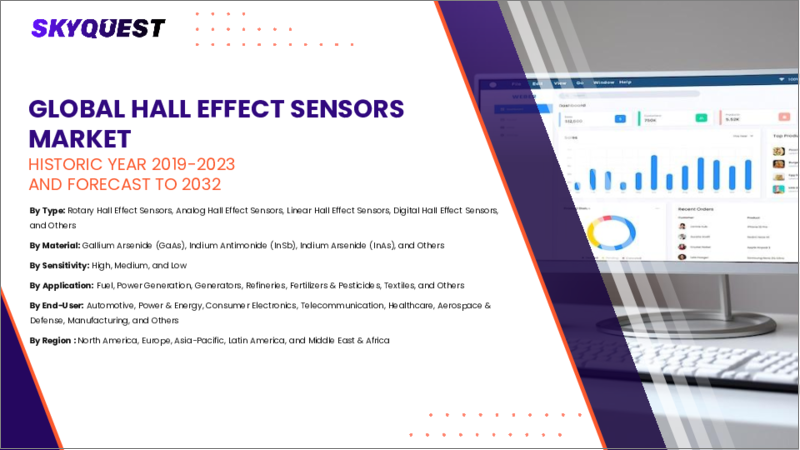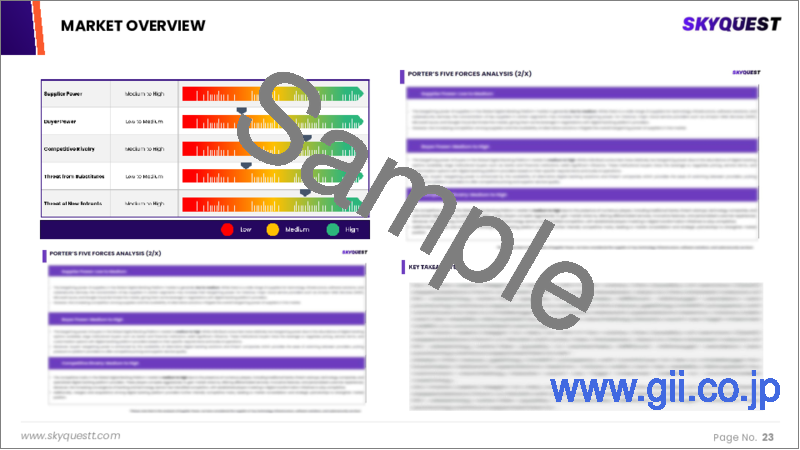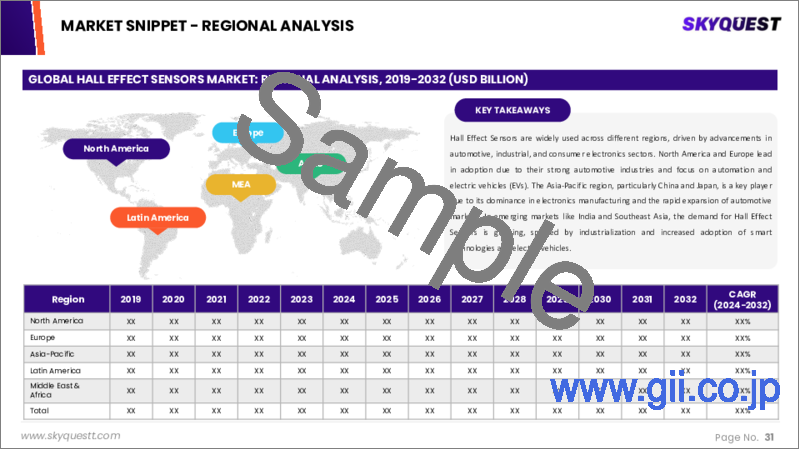|
|
市場調査レポート
商品コード
1655910
ホール効果センサーの市場規模、シェア、成長分析:技術別、材料別、感度別、用途別、最終用途別、地域別 - 産業予測、2025年~2032年Hall Effect Sensors Market Size, Share, and Growth Analysis, By Technology, By Material (Indium Antimonide, Gallium Arsenide ), By Sensitivity, By Application, By End Use, By Region - Industry Forecast 2025-2032 |
||||||
|
|||||||
| ホール効果センサーの市場規模、シェア、成長分析:技術別、材料別、感度別、用途別、最終用途別、地域別 - 産業予測、2025年~2032年 |
|
出版日: 2025年02月11日
発行: SkyQuest
ページ情報: 英文 197 Pages
納期: 3~5営業日
|
全表示
- 概要
- 目次
ホール効果センサーの市場規模は2023年に22億7,000万米ドルとなり、予測期間(2025年~2032年)のCAGRは7.9%で、2024年の24億5,000万米ドルから2032年には45億米ドルに成長する見通しです。
世界のホール効果センサー市場は、自動車分野での需要の高まり、産業オートメーションの増加、民生用電子機器の展望の拡大に後押しされ、大きな成長を遂げています。スマートフォン、タブレット、ウェアラブルなどのデバイスの普及が、近接検出やゲーム制御などのアプリケーションにおけるこれらのセンサーのニーズを促進しています。電気自動車(EV)や先進運転支援システム(ADAS)の普及に伴い、ホール効果センサーは車輪速度やスロットル開度検知などの機能に欠かせないものとなっています。さらに、IoTブームにより、磁界検知やデバイス接続への応用も進んでいます。センサーの設計における技術的進歩は、性能と信頼性をさらに向上させ、複数の産業における役割を確固たるものにし、市場の持続的な拡大を確実なものにしています。
目次
イントロダクション
- 調査の目的
- 調査範囲
- 定義
調査手法
- 情報調達
- 二次と一次データの方法
- 市場規模予測
- 市場の前提条件と制限
エグゼクティブサマリー
- 世界市場の見通し
- 供給と需要の動向分析
- セグメント別機会分析
市場力学と見通し
- 市場概要
- 市場規模
- 市場力学
- 促進要因と機会
- 抑制要因と課題
- ポーターの分析
主な市場の考察
- 重要成功要因
- 競合の程度
- 主な投資機会
- 市場エコシステム
- 市場の魅力指数(2024年)
- PESTEL分析
- マクロ経済指標
- バリューチェーン分析
- 価格分析
ホール効果センサーの市場規模:技術別 & CAGR(2025年~2032年)
- 市場概要
- リニアホール効果センサー
- ロータリーホール効果センサー
- デジタルホール効果センサー
- アナログホール効果センサー
- しきい値ホール効果センサー
- バイポーラーホール効果センサー
ホール効果センサーの市場規模:材料別 & CAGR(2025年~2032年)
- 市場概要
- インジウムアンチモン(InSb)
- ガリウムヒ素(GaAs)
- インジウムヒ素(InAs)
- その他
ホール効果センサーの市場規模:感度別 & CAGR(2025年~2032年)
- 市場概要
- 高感度
- 中感度
- 低感度
ホール効果センサーの市場規模:用途別 & CAGR(2025年~2032年)
- 市場概要
- 位置検知
- 速度感知
- 電流検知
- 温度感知
- その他
ホール効果センサーの市場規模:最終用途別 & CAGR(2025年~2032年)
- 市場概要
- 自動車
- 家電
- 産業
- ヘルスケア
- 航空宇宙および防衛
- エネルギーと公共事業
- その他
ホール効果センサーの市場規模 & CAGR(2025年~2032年)
- 北米
- 米国
- カナダ
- 欧州
- ドイツ
- スペイン
- フランス
- 英国
- イタリア
- その他欧州
- アジア太平洋
- 中国
- インド
- 日本
- 韓国
- その他アジア太平洋
- ラテンアメリカ
- ブラジル
- その他ラテンアメリカ
- 中東・アフリカ
- GCC諸国
- 南アフリカ
- その他中東・アフリカ
競合情報
- 上位5社の比較
- 主要企業の市場ポジショニング(2024年)
- 主な市場企業が採用した戦略
- 最近の市場動向
- 企業の市場シェア分析(2024年)
- 主要企業の企業プロファイル
- 企業の詳細
- 製品ポートフォリオ分析
- 企業のセグメント別シェア分析
- 収益の前年比比較(2022年~2024年)
主要企業プロファイル
- Allegro MicroSystems(米国)
- Infineon Technologies AG(ドイツ)
- TDK Corporation(日本)
- Honeywell International Inc.(米国)
- Melexis NV(ベルギー)
- ams OSRAM AG(オーストリア)
- NXP Semiconductors N.V.(オランダ)
- Asahi Kasei Microdevices Corporation(日本)
- Diodes Incorporated(米国)
- TT Electronics plc(英国)
- LEM Holding SA(スイス)
- Coto Technology(米国)
- Crocus Technology(フランス)
- Phoenix Contact GmbH & Co. KG(ドイツ)
- Texas Instruments Incorporated(米国)
- Analog Devices, Inc.(米国)
- Renesas Electronics Corporation(日本)
- ROHM Co., Ltd.(日本)
- Alps Alpine Co., Ltd.(日本)
結論と提言
Hall Effect Sensors Market size was valued at USD 2.27 billion in 2023 and is poised to grow from USD 2.45 billion in 2024 to USD 4.5 billion by 2032, growing at a CAGR of 7.9% during the forecast period (2025-2032).
The global Hall Effect sensors market is experiencing significant growth, fueled by rising demand in the automotive sector, increased industrial automation, and an expanding consumer electronics landscape. The proliferation of devices such as smartphones, tablets, and wearables is driving the need for these sensors in applications like proximity detection and gaming controls. As electric vehicles (EVs) and advanced driver-assistance systems (ADAS) become more prevalent, Hall Effect sensors are crucial for functions like wheel speed and throttle position sensing. Moreover, the IoT boom enhances their application in magnetic field detection and device connectivity. Technological advancements in sensor design are further improving performance and reliability, solidifying their role across multiple industries and ensuring sustained market expansion.
Top-down and bottom-up approaches were used to estimate and validate the size of the Hall Effect Sensors market and to estimate the size of various other dependent submarkets. The research methodology used to estimate the market size includes the following details: The key players in the market were identified through secondary research, and their market shares in the respective regions were determined through primary and secondary research. This entire procedure includes the study of the annual and financial reports of the top market players and extensive interviews for key insights from industry leaders such as CEOs, VPs, directors, and marketing executives. All percentage shares split, and breakdowns were determined using secondary sources and verified through Primary sources. All possible parameters that affect the markets covered in this research study have been accounted for, viewed in extensive detail, verified through primary research, and analyzed to get the final quantitative and qualitative data.
Hall Effect Sensors Market Segments Analysis
Global Hall Effect Sensors Market is segmented by Technology, Material, Sensitivity, Application, End Use and region. Based on Technology, the market is segmented into Linear hall effect sensors, Rotary Hall Effect Sensors, Digital Hall Effect Sensors, Analog Hall Effect Sensors, Threshold hall effect sensors and Bipolar hall effect sensors. Based on Material, the market is segmented into Indium Antimonide (InSb), Gallium Arsenide (GaAs), Indium Arsenide (InAs) and Others. Based on Sensitivity, the market is segmented into High Sensitivity, Medium Sensitivity and Low Sensitivity. Based on Application, the market is segmented into Position sensing, Speed sensing, Current sensing, Temperature sensing and Others. Based on End Use, the market is segmented into Automotive, Consumer electronics, Industrial, Healthcare, Aerospace & defense, Energy & utilities and Others. Based on region, the market is segmented into North America, Europe, Asia Pacific, Latin America and Middle East & Africa.
Driver of the Hall Effect Sensors Market
A significant factor propelling the global Hall Effect Sensors market is the surging demand for electric vehicles (EVs) across the globe. These sensors are essential to the functionality of EVs, facilitating crucial operations such as battery management, motor control, and position sensing. As environmental concerns regarding carbon emissions escalate and the transition to clean energy intensifies, the adoption of electric vehicles is rapidly increasing. This trend is anticipated to drive up the demand for Hall Effect Sensors within the automotive sector, thereby contributing to robust market growth in the years ahead.
Restraints in the Hall Effect Sensors Market
A significant constraint facing the global Hall Effect sensors market is the relatively high cost associated with these sensors compared to other sensing technologies. The manufacturing process for Hall Effect sensors involves specialized materials and techniques, leading to elevated production costs. This financial barrier restricts access for small and medium-sized enterprises, which diminishes their integration across various sectors. Additionally, the presence of alternative sensing solutions, like inductive and capacitive sensors, which provide comparable functionalities at a more affordable price, further hampers the expansion of the Hall Effect sensors market. These factors collectively contribute to the limited adoption of Hall Effect sensors in many applications.
Market Trends of the Hall Effect Sensors Market
The global Hall Effect Sensors market is witnessing a significant trend driven by the rising adoption of micro-electromechanical systems (MEMS) technology in sensor manufacturing. This advancement facilitates the integration of numerous sensing elements, signal processing, and control electronics onto a single chip, resulting in sensors that are not only more compact but also exhibit enhanced precision and cost-effectiveness. As a consequence, the utilization of Hall Effect Sensors is projected to expand in diverse sectors, including automotive, industrial, and consumer electronics. This integration and innovation will likely propel market growth, positioning Hall Effect Sensors as a crucial component in modern electronic applications in the coming years.
Table of Contents
Introduction
- Objectives of the Study
- Scope of the Report
- Definitions
Research Methodology
- Information Procurement
- Secondary & Primary Data Methods
- Market Size Estimation
- Market Assumptions & Limitations
Executive Summary
- Global Market Outlook
- Supply & Demand Trend Analysis
- Segmental Opportunity Analysis
Market Dynamics & Outlook
- Market Overview
- Market Size
- Market Dynamics
- Drivers & Opportunities
- Restraints & Challenges
- Porters Analysis
- Competitive rivalry
- Threat of substitute
- Bargaining power of buyers
- Threat of new entrants
- Bargaining power of suppliers
Key Market Insights
- Key Success Factors
- Degree of Competition
- Top Investment Pockets
- Market Ecosystem
- Market Attractiveness Index, 2024
- PESTEL Analysis
- Macro-Economic Indicators
- Value Chain Analysis
- Pricing Analysis
Global Hall Effect Sensors Market Size by Technology & CAGR (2025-2032)
- Market Overview
- Linear hall effect sensors
- Rotary Hall Effect Sensors
- Digital Hall Effect Sensors
- Analog Hall Effect Sensors
- Threshold hall effect sensors
- Bipolar hall effect sensors
Global Hall Effect Sensors Market Size by Material & CAGR (2025-2032)
- Market Overview
- Indium Antimonide (InSb)
- Gallium Arsenide (GaAs)
- Indium Arsenide (InAs)
- Others
Global Hall Effect Sensors Market Size by Sensitivity & CAGR (2025-2032)
- Market Overview
- High Sensitivity
- Medium Sensitivity
- Low Sensitivity
Global Hall Effect Sensors Market Size by Application & CAGR (2025-2032)
- Market Overview
- Position sensing
- Speed sensing
- Current sensing
- Temperature sensing
- Others
Global Hall Effect Sensors Market Size by End Use & CAGR (2025-2032)
- Market Overview
- Automotive
- Consumer electronics
- Industrial
- Healthcare
- Aerospace & defense
- Energy & utilities
- Others
Global Hall Effect Sensors Market Size & CAGR (2025-2032)
- North America (Technology, Material, Sensitivity, Application, End Use)
- US
- Canada
- Europe (Technology, Material, Sensitivity, Application, End Use)
- Germany
- Spain
- France
- UK
- Italy
- Rest of Europe
- Asia Pacific (Technology, Material, Sensitivity, Application, End Use)
- China
- India
- Japan
- South Korea
- Rest of Asia-Pacific
- Latin America (Technology, Material, Sensitivity, Application, End Use)
- Brazil
- Rest of Latin America
- Middle East & Africa (Technology, Material, Sensitivity, Application, End Use)
- GCC Countries
- South Africa
- Rest of Middle East & Africa
Competitive Intelligence
- Top 5 Player Comparison
- Market Positioning of Key Players, 2024
- Strategies Adopted by Key Market Players
- Recent Developments in the Market
- Company Market Share Analysis, 2024
- Company Profiles of All Key Players
- Company Details
- Product Portfolio Analysis
- Company's Segmental Share Analysis
- Revenue Y-O-Y Comparison (2022-2024)
Key Company Profiles
- Allegro MicroSystems (United States)
- Company Overview
- Business Segment Overview
- Financial Updates
- Key Developments
- Infineon Technologies AG (Germany)
- Company Overview
- Business Segment Overview
- Financial Updates
- Key Developments
- TDK Corporation (Japan)
- Company Overview
- Business Segment Overview
- Financial Updates
- Key Developments
- Honeywell International Inc. (United States)
- Company Overview
- Business Segment Overview
- Financial Updates
- Key Developments
- Melexis NV (Belgium)
- Company Overview
- Business Segment Overview
- Financial Updates
- Key Developments
- ams OSRAM AG (Austria)
- Company Overview
- Business Segment Overview
- Financial Updates
- Key Developments
- NXP Semiconductors N.V. (Netherlands)
- Company Overview
- Business Segment Overview
- Financial Updates
- Key Developments
- Asahi Kasei Microdevices Corporation (Japan)
- Company Overview
- Business Segment Overview
- Financial Updates
- Key Developments
- Diodes Incorporated (United States)
- Company Overview
- Business Segment Overview
- Financial Updates
- Key Developments
- TT Electronics plc (United Kingdom)
- Company Overview
- Business Segment Overview
- Financial Updates
- Key Developments
- LEM Holding SA (Switzerland)
- Company Overview
- Business Segment Overview
- Financial Updates
- Key Developments
- Coto Technology (United States)
- Company Overview
- Business Segment Overview
- Financial Updates
- Key Developments
- Crocus Technology (France)
- Company Overview
- Business Segment Overview
- Financial Updates
- Key Developments
- Phoenix Contact GmbH & Co. KG (Germany)
- Company Overview
- Business Segment Overview
- Financial Updates
- Key Developments
- Texas Instruments Incorporated (United States)
- Company Overview
- Business Segment Overview
- Financial Updates
- Key Developments
- Analog Devices, Inc. (United States)
- Company Overview
- Business Segment Overview
- Financial Updates
- Key Developments
- Renesas Electronics Corporation (Japan)
- Company Overview
- Business Segment Overview
- Financial Updates
- Key Developments
- ROHM Co., Ltd. (Japan)
- Company Overview
- Business Segment Overview
- Financial Updates
- Key Developments
- Alps Alpine Co., Ltd. (Japan)
- Company Overview
- Business Segment Overview
- Financial Updates
- Key Developments






